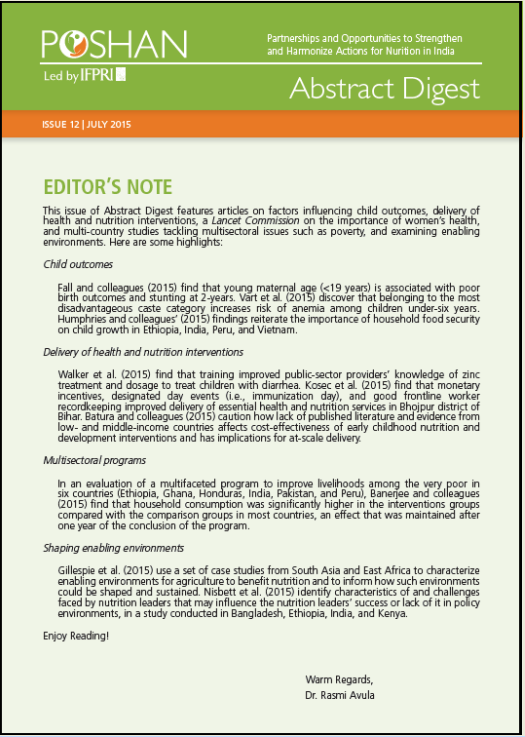 This issue of Abstract Digest features articles on factors influencing child outcomes, delivery of health and nutrition interventions, a Lancet Commission on the importance of women’s health, and multi-country studies tackling multisectoral issues such as poverty, and examining enabling environments. Here are some highlights:
This issue of Abstract Digest features articles on factors influencing child outcomes, delivery of health and nutrition interventions, a Lancet Commission on the importance of women’s health, and multi-country studies tackling multisectoral issues such as poverty, and examining enabling environments. Here are some highlights:
Child outcomes
Fall and colleagues (2015) find that young maternal age (<19 years) is associated with poor birth outcomes and stunting at 2-years. Vart et al. (2015) discover that belonging to the most disadvantageous caste category increases risk of anemia among children under-six years. Humphries and colleagues’ (2015) findings reiterate the importance of household food security on child growth in Ethiopia, India, Peru, and Vietnam.
Delivery of health and nutrition interventions
Walker et al. (2015) find that training improved public-sector providers’ knowledge of zinc treatment and dosage to treat children with diarrhea. Kosec et al. (2015) find that monetary incentives, designated day events (i.e., immunization day), and good frontline worker recordkeeping improved delivery of essential health and nutrition services in Bhojpur district of Bihar. Batura and colleagues (2015) caution how lack of published literature and evidence from low- and middle-income countries affects cost-effectiveness of early childhood nutrition and development interventions and has implications for at-scale delivery.
Multisectoral programs
In an evaluation of a multifaceted program to improve livelihoods among the very poor in six countries (Ethiopia, Ghana, Honduras, India, Pakistan, and Peru), Banerjee and colleagues (2015) find that household consumption was significantly higher in the interventions groups compared with the comparison groups in most countries, an effect that was maintained after one year of the conclusion of the program.
Shaping enabling environments
Gillespie et al. (2015) use a set of case studies from South Asia and East Africa to characterize enabling environments for agriculture to benefit nutrition and to inform how such environments could be shaped and sustained. Nisbett et al. (2015) identify characteristics of and challenges faced by nutrition leaders that may influence the nutrition leaders’ success or lack of it in policy environments, in a study conducted in Bangladesh, Ethiopia, India, and Kenya.


